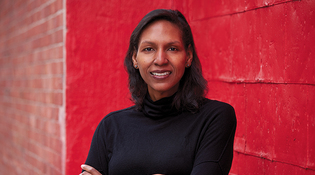 loading
loading
MilestonesNew director for Center for British ArtCourtney J. Martin is a fan of Louis Kahn—and Ashley’s Ice Cream.  Argenis ApolinarioCourtney J. Martin ’09PhD, the new director of the Center for British Art, studies the art of the British Commonwealth. View full imageOne minute into our conversation, Courtney J. Martin ’09PhD—the new director of the Yale Center for British Art (YCBA)—has already broken a cardinal rule: she’s admitted to a favorite work of art in the collection. But there’s a twist. Martin is most excited about the museum building itself. One of the last works of the architect Louis Kahn, the center, which opened in 1977, was created to house the YCBA’s art. “It’s a beautiful building, and it’s purpose-built for the collection,” says Martin. She is particularly enthralled by the fact that it faces the Yale University Art Gallery, one of Kahn’s earliest designs (1953). To Martin, a pair of Kahns in mirror opposition, rhyming with and contrasting with each other, represents the founding principle of the teaching of art history: “You look at two images of objects and you compare and contrast.” Martin is returning to Yale after a decade away. As a graduate student, she worked on a 2007 YCBA exhibition on art and emancipation in Jamaica. After writing a dissertation on British art since 1968, she continued her research on what can broadly be described as the Commonwealth: art from England, Scotland, Ireland, Wales, and the former colonies. “I am interested in the ways in which those places were shaped by and in turn shaped the visual culture that could largely be called British,” she says. An assistant professor at Vanderbilt before she joined the faculty at Brown in 2013, Martin became an adjunct curator at the Dia Art Foundation in 2015. Two years later, she left Brown to become Dia’s deputy director and chief curator. She began her role as YCBA director in July. Martin says there are several aspects of New Haven she’s excited about returning to, including close proximity to Ashley’s Ice Cream. But having just left New York City—where most major art institutions charge nontrivial entrance fees—she sees a huge advantage at the YCBA. “I think the best thing about the center, outside of its building, collection, and staff, is that it’s free,” says Martin. “And I cannot state that enough.” Martin follows Amy Meyers, who was director for nearly 20 years. When asked what she hopes her legacy might be after two decades, Martin laughs, then pauses. “I hope that people see [the YCBA] as a place they can come in and wander around even for a few minutes,” she says. “There is nothing you need to walk through our doors. We don’t expect anything from you. We just want you to come in.”
The comment period has expired.
|
|